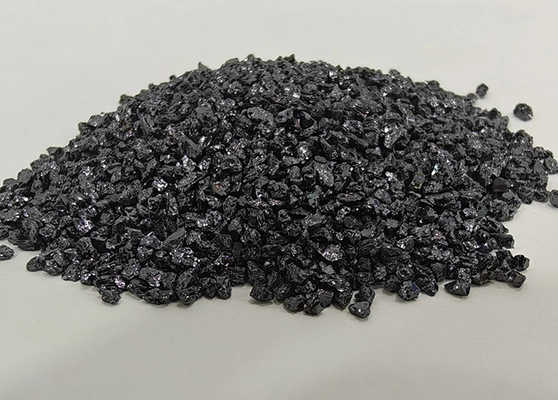Quick answer: Use brown fused alumina (BFA) in a blast cabinet at 30–60 psi (2.1–4.1 bar) with 80–120 grit, 6–10 in (150–250 mm) standoff, and a 60–90° angle. Aim for a clean matte surface with Ra ≈ 0.8–2.5 μm (32–100 μin) depending on coating. Finish with rinse/degrease → conversion coat or primer to slow re-oxidation.
Aluminum Oxide 101 (Al2O3)
Aluminum spontaneously forms a thin oxide film in air:
4Al + 3O2 → 2Al2O3
This film protects the base metal but can chalk, trap contaminants, and undermine coatings or bonding. Mechanical cleaning with a controlled abrasive blast restores a fresh, uniform surface and a measurable profile for paint, powder coat, adhesive, or anodizing.
When to Choose BFA vs. Alternatives
- BFA (Brown Fused Alumina) – Angular, tough, economical, and recyclable. Excellent for rapid oxide removal, coating prep, and cabinet/booth blasting.
- White Fused Alumina (WFA) – Cleaner/whiter finish and lower contamination risk; pick for cosmetic parts and fine satin finishes.
- Silicon Carbide (SiC) – Very sharp and friable; ideal when you need aggressive cut with a fine finish (e.g., hard-anodize prep).
- Chemical-only cleaning – Alkaline/acid brightening can remove light films but won’t level pitting or scratches as uniformly as blasting.
Tools & Materials
- Blast cabinet or pressure pot with reliable moisture/oil separation
- Nozzle: boron carbide or SiC, 6–8 mm (¼–5/16 in) orifice for cabinets
- Media: BFA 80–120 grit for oxide removal / paint prep; 150–180 for cosmetic satin
- Air supply: dry, oil-free; adequate CFM for chosen nozzle
- Masking: tapes/plugs for threads, fits, and sealing lands
- Cleaning: neutral pH degreaser, DI water, lint-free wipes
- Post-treatment: chromate-free conversion coat, etch primer, or anodizing
- PPE: eye/face, hearing, gloves, and respirator (P100/EN143)
Step-by-Step Workflow
- Degrease first. Remove oils so contaminants aren’t driven into the surface. Rinse and dry.
- Mask critical features. Protect threads, bearing seats, and precision surfaces.
- Charge media. Use fresh BFA for cosmetic work; reclaimed media is fine if fines < 20%.
- Set starting parameters. 40 psi (2.8 bar), 80–120 grit, 6–10 in standoff, 60–90° angle.
- Qualify on a coupon. Check that oxidation is removed and the texture meets the target Ra.
- Blast the part. Keep the nozzle moving with 30–50% overlap; do not linger to avoid dimpling.
- Final clean. Blow down with dry air; DI rinse if needed; dry with warm air immediately.
- Protect. Apply conversion coat/primer within 30–60 minutes to minimize re-oxidation.
Recommended Parameters
| Target | Grit (FEPA) | Pressure | Nozzle Angle | Standoff | Finish / Profile |
|---|---|---|---|---|---|
| Heavy oxide / pre-paint | 80–100 | 45–60 psi (3.1–4.1 bar) | 70–90° | 6–8 in (150–200 mm) | Ra ≈ 1.5–2.5 μm (60–100 μin) |
| General oxidation / powder coat | 100–120 | 35–50 psi (2.4–3.4 bar) | 60–80° | 6–10 in (150–250 mm) | Ra ≈ 1.0–1.8 μm (40–70 μin) |
| Cosmetic satin / bonding prep | 150–180 | 30–40 psi (2.1–2.8 bar) | 60–70° | 8–10 in (200–250 mm) | Ra ≈ 0.8–1.2 μm (32–50 μin) |
Tip: If the surface darkens or “smears,” reduce pressure, move closer to 90°, or step to a sharper media like SiC.
Media & Nozzle Selection Checklist
- Define the finish: Ra/profile target and coating spec (e.g., primer window).
- Pick grit: 80–120 for oxide removal; 150–180 for satin or adhesive bonding.
- Hardness vs. embedment: For critical cosmetic parts, consider WFA or finer BFA to reduce embedment risk.
- Air & nozzle: Match CFM to nozzle bore; use boron-carbide for long life with BFA.
- Media lifecycle: Sift fines; refresh when cut rate drops or dust rises.
- Cleanliness: Ensure low oil/water; contaminated air leaves stains and adhesion issues.
Post-Treatment & Corrosion Protection
- Rinse / neutral clean: Remove dust and residues; avoid alkaline residues under paint.
- Flash rust prevention: Not a steel issue, but aluminum re-oxidizes quickly; coat promptly.
- Conversion coat: Apply a chromate-free conversion coating before primer for maximum adhesion.
- Primer/paint: Follow the coating maker’s blast profile and recoat window.
- Anodizing: If anodizing, consult the processor for acceptable blast parameters to avoid excessive roughness.
Troubleshooting
- Gray/dull staining: Media contamination or too shallow angle. Refresh media; increase angle to 80–90°.
- Uneven finish / tiger striping: Inconsistent traverse speed; overlap 30–50% and keep steady distance.
- Slow cut: Excess fines or low pressure. Sieve/refresh media; raise pressure in 5 psi steps.
- Peening/dimpling: Pressure too high or stand-off too short. Reduce to 35–45 psi and 6–8 in.
- Poor coating adhesion: Missed degrease or re-oxidation delay. Reclean, rebast, and coat within 1 hour.
FAQs
Will BFA embed in aluminum?
At moderate pressures (30–50 psi) with 100–150 grit and near-normal angles, embedment is minimal. For critical cosmetic parts, use finer grit or switch to WFA.
What profile do I need for paint or powder?
Most primers/powders accept Ra 1.0–2.0 μm (40–80 μin). Confirm with the coating data sheet and qualify with a coupon.
Can I use BFA on anodized aluminum?
Blasting will remove or dull anodize. If the goal is to strip and refinish, yes—use 100–120 grit at 35–45 psi, then follow the anodizer’s prep requirements.
Cabinet vs. open blasting?
Cabinets give better control, reclamation, and cleanliness; open blasting is faster for large items but needs tight media and dust control to avoid contamination.
What’s the chemical formula of aluminum oxide?
Al2O3. Typical formation on bare aluminum: 4Al + 3O2 → 2Al2O3.
Related Products & Guides
- Brown Fused Alumina – Coarse Grit
- Brown Fused Alumina – Powder (Microgrits)
- White Fused Alumina for Cosmetic Blasting
Conclusion
Brown fused alumina is a fast, controllable, and economical way to remove aluminum oxidation and create a coating-ready surface. Start with 80–120 grit at 30–60 psi, qualify your finish on a coupon, and protect the surface promptly. With the right media, parameters, and workflow, you’ll consistently achieve clean, uniform aluminum ready for paint, powder, bonding, or anodize.
